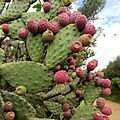Woollyjoint pricklypear facts for kids
{{Speciesbox | image = Opuntia tomentosa (Cactaceae) - Nopal chamacuelo.jpg | image_caption = | genus = Opuntia | species = tomentosa | status = LC | status_system = IUCN3.1 | status_ref = | authority = Salm-Dyck
| synonyms =
- Opuntia hernandezii DC.
- Opuntia icterica Griffiths
- Opuntia macdougaliana Rose
- Opuntia oblongata Wendland
- Opuntia sarca Griffiths ex Scheinvar
- Opuntia tomentosa var. hernandezii (DC.) Bravo
- Opuntia tomentosa var. herrerae Scheinvar
- Opuntia velutina var. macdougaliana (Rose) Bravo
}
Opuntia tomentosa, often called the woollyjoint pricklypear or velvety tree pear, is a type of cactus found in Mexico. It gets its common names from the soft, fuzzy hairs that cover its pads, making it feel like velvet or wool. This cactus is part of the Opuntia genus, which includes many well-known pricklypear cacti.
Contents
What is the Woollyjoint Pricklypear?
The woollyjoint pricklypear is a unique plant that can grow quite tall, sometimes looking more like a small tree than a typical cactus. Its stem segments, also known as pads or cladodes, are covered in fine, soft hairs. These hairs give the plant a fuzzy, velvety feel, which is where its common names come from. Like other pricklypears, it also has sharp spines and tiny, barbed bristles called glochids.
Where Does This Cactus Grow?
Opuntia tomentosa is native to Mexico. It thrives in dry, warm environments, often found in deserts, scrublands, and rocky areas. Mexico is home to many different types of cacti, and the woollyjoint pricklypear is one of its interesting native species. It has adapted well to these tough conditions, storing water in its thick pads to survive long periods without rain.
How Does It Grow and Reproduce?
Like most cacti, the woollyjoint pricklypear grows slowly. It produces flowers that can be yellow or orange, which then turn into edible fruits. These fruits are often called "tunas" or "prickly pears." The plant can reproduce in a few ways:
- Seeds: After the flowers are pollinated, they develop into fruits containing seeds. When these seeds are spread, new plants can grow.
- Pad segments: A common way for pricklypears to spread is if a pad breaks off and falls to the ground. If conditions are right, the detached pad can root and grow into a new plant. This helps the cactus spread easily in its natural habitat.
What Are Pricklypear Cacti Used For?
Many types of pricklypear cacti, including those related to Opuntia tomentosa, have been used by people for a long time, especially in Mexico.
- Food: The pads of some pricklypear cacti, called "nopales," are eaten as a vegetable. They are often cooked and added to salads, tacos, or stews. The fruits, or "tunas," are sweet and juicy and can be eaten fresh or made into jams and drinks.
- Medicine: Some traditional medicines use parts of the pricklypear cactus for various health benefits.
- Animal Feed: In some dry regions, pricklypear cacti are used as a source of food for livestock, especially during droughts when other plants are scarce.
Images for kids
See also
In Spanish: Opuntia tomentosa para niños


